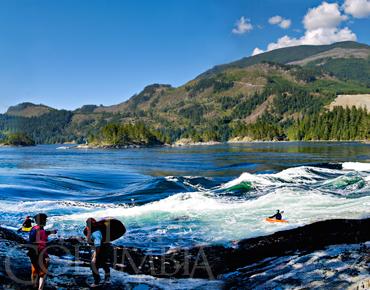
Picture a river. The kind daredevil kayakers dream about—and dread.
Angry rapids cascade into metre-high whitecaps and churning whirlpools. Brightly coloured kayaks blur by. But then the current slows, rapids calm, and that raging river turns glassy smooth. And here’s where it gets really weird. Water begins to flow backward. Slowly, steadily, the current picks up until whitewater is surging in the opposite direction, flouting physics, geology, and common sense. Those same kayaks race back the other way, their helmeted riders paddling desperately to stay upright.
Welcome to Skookumchuck Narrows Provincial Park, which includes an extraordinary set of tidal rapids near the village of Egmont on the Sunshine Coast. Here, the Sechelt Inlet constricts to a few hundred metres before opening to Jervis Inlet, then the Pacific. When the tide comes in, hundreds of billions of litres of water are forced through, creating a maelstrom strong enough to flip tugboats. When the tide goes out, the same spectacle repeats itself in reverse.
Fog is flirting with drizzle as I near the trailhead to the rapids. After winding several kilometres through a primordial landscape, I reach the Narrows. Even if it weren’t for the fence and the warning signs, the boiling black water would likely keep the curious at a safe distance. A fellow hiker explains the origin of the Narrows’ name. “In Chinook jargon, the word ‘skookum’ means strong; ‘chuck’ means water,” he says. Out in the choppy inlet, kelp and debris swirl in curious spirals. A long, jagged row of whitecaps splits the middle of the channel.
Skookumchuck enthusiasts schedule visits to correspond with the twice-daily tidal surges, when the difference in water level from one side of the rapids to the other is so great that huge stationary waves form, breaking for hours in the same spot and often drawing in dozens of hardcore kayakers. Today, the thrill-seekers are gone, but the rapidly ebbing water has left something interesting in its wake—flourishing tidal pools.
The waters here are rich in plankton and oxygen, supporting brilliant-coloured marine life more often associated with tropical reefs. I find red and green anemones growing in clusters along the rocks, packed in with barnacles, sponges, and mussels. Sunflower stars, more than a half-metre long, are a riot of purple and orange arms glimmering just below the waterline.
As I turn to go, raindrops ding the calm surface of the inlet, momentarily slack between tides. Somewhere out in the Pacific, a few hundred billion litres of seawater is barreling shoreward on a crash course once again with the Skookumchuck Narrows.
Getting there
Travel by BC Ferries from Horseshoe Bay to Langdale on the Sunshine Coast. Follow Highway 101 past Sechelt and Madeira Park. Just before Earls Cove, take a right on Egmont Road and follow it for six kilometres to the trailhead and parking lot (www.bcparks.ca).

